Amherst College

Amherst College

| Motto | Terras Irradient (Latin) |
|---|---|
Motto in English | Let them enlighten the lands[1] |
| Type | Private |
| Established | 1821 |
| Endowment | $2.378 billion (2018)[2] |
| President | Carolyn Martin |
Academic staff | 300 (Fall 2018)[3] |
| Undergraduates | 1,855 (Fall 2018)[3] |
| Location | Amherst ,,United States |
| Campus | Rural 1,000 acres (4.0 km2) |
| Colors | Purple and white[4] |
| Athletics | NCAA Division III – NESCAC |
Sporting affiliations | Annapolis Group NEASC AICUM 568 Group NAICU |
| Mascot | Mammoths (formerly Lord Jeffs) |
| Website | www.amherst.edu [109] |
| University rankings | |
| National | |
| Forbes[27] | 28 |
| Times/WSJ[28] | 22 |
| Liberal arts colleges | |
| U.S. News & World Report[29] | 2 |
| Washington Monthly[30] | 3 |
Amherst College (/ˈæmərst/ (listen)[5] AM-ərst) is a private liberal arts college in Amherst, Massachusetts. Founded in 1821 as an attempt to relocate Williams College by its then-president Zephaniah Swift Moore, Amherst is the third oldest institution of higher education in Massachusetts.[6] The institution was named after the town, which in turn had been named after Jeffery, Lord Amherst, Commander-in-Chief of British forces of North America during the French and Indian War. Originally established as a men's college, Amherst became coeducational in 1975.[7]
Amherst is an exclusively undergraduate four-year institution; the school enrolled 1,855 students in fall 2018.[8][9] Students choose courses from 38 major programs in an open curriculum[10] and are not required to study a core curriculum or fulfill any distribution requirements; students may also design their own interdisciplinary major.[11] For the class of 2023, Amherst received 10,567 applications and accepted 1,144, yielding a 10.8% acceptance rate.[12] Amherst was ranked as the best liberal arts college in the country for 2018–19 by The Wall Street Journal,[13] the second best liberal arts college in the country by U.S. News & World Report,[14] and 16th out of all U.S. colleges and universities by Forbes[15] in their 2018 rankings. Amherst competes in the New England Small College Athletic Conference.
Amherst has historically had close relationships and rivalries with Williams College and Wesleyan University, which form the Little Three colleges. The college is a member of the Five College Consortium, which allows its students to attend classes at four other Pioneer Valley institutions: Mount Holyoke College, Smith College, Hampshire College, and the University of Massachusetts Amherst.
| Motto | Terras Irradient (Latin) |
|---|---|
Motto in English | Let them enlighten the lands[1] |
| Type | Private |
| Established | 1821 |
| Endowment | $2.378 billion (2018)[2] |
| President | Carolyn Martin |
Academic staff | 300 (Fall 2018)[3] |
| Undergraduates | 1,855 (Fall 2018)[3] |
| Location | Amherst ,,United States |
| Campus | Rural 1,000 acres (4.0 km2) |
| Colors | Purple and white[4] |
| Athletics | NCAA Division III – NESCAC |
Sporting affiliations | Annapolis Group NEASC AICUM 568 Group NAICU |
| Mascot | Mammoths (formerly Lord Jeffs) |
| Website | www.amherst.edu [109] |
| University rankings | |
| National | |
| Forbes[27] | 28 |
| Times/WSJ[28] | 22 |
| Liberal arts colleges | |
| U.S. News & World Report[29] | 2 |
| Washington Monthly[30] | 3 |
History
Founding and 19th century

Main Quad
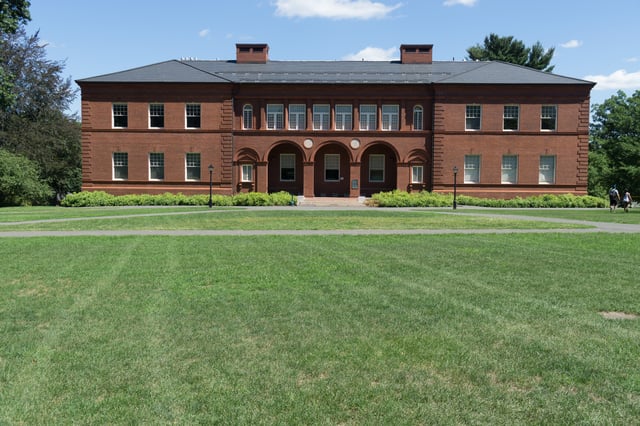
Fayerweather Hall
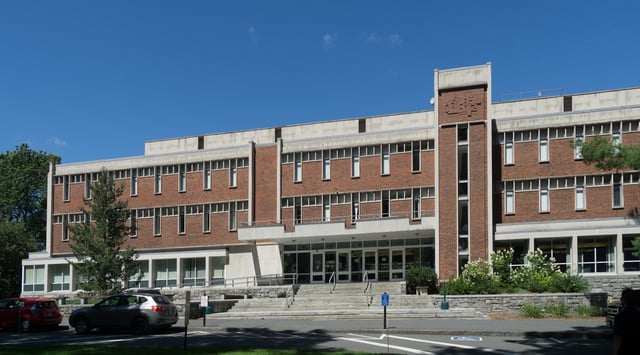
Frost Library
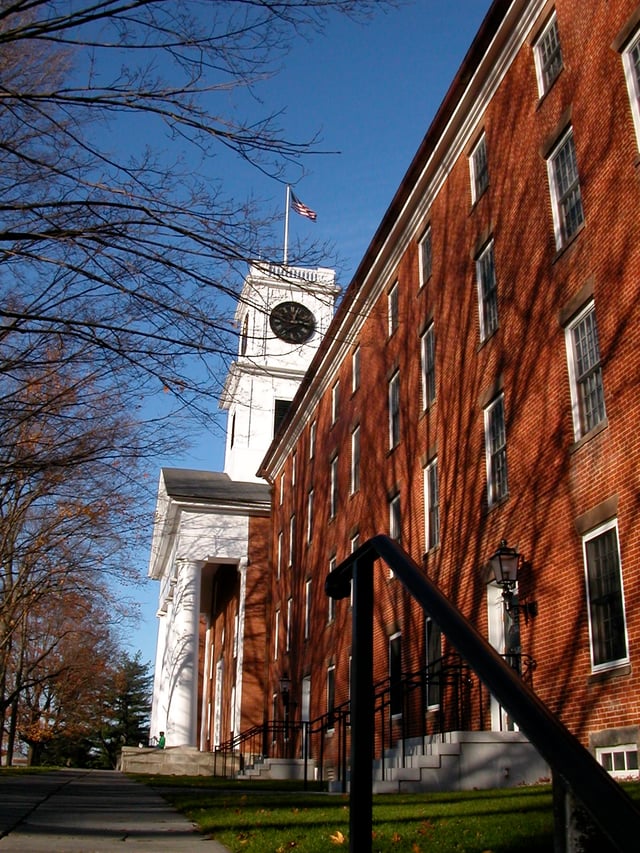
College Row, consisting of Williston, South, North, and Appleton Halls, with Johnson Chapel at center
Founded in 1821, Amherst College developed out of the secondary school Amherst Academy. The college was originally suggested as an alternative to Williams College, which was struggling to stay open. Although Williams survived, Amherst was formed and diverged into its own institution.[16]
In 1812, funds were raised in Amherst for a secondary school, Amherst Academy; it opened December 1814.[17] The academy incorporated in 1816.[18] The institution was named after the town, which in turn had been named after Jeffery, Lord Amherst, a veteran from the Seven Years' War and later commanding general of the British forces in North America. On November 18, 1817, a project was adopted at the Academy to raise funds for the free instruction of "indigent young men of promising talents and hopeful piety, who shall manifest a desire to obtain a liberal education with a sole view to the Christian ministry."[19] This required a substantial investment from benefactors.[16]
During the fundraising for the project, it became clear that without larger designs, it would be impossible to raise sufficient funds. This led the committee overseeing the project to conclude that a new institution should be created. On August 18, 1818, the Amherst Academy board of trustees accepted this conclusion and began building a new college.[16]
Establishment
Moore, then President of Williams College, however, still believed that Williamstown was an unsuitable location for a college, and with the advent of Amherst College was elected its first president on May 8, 1821. At its opening, Amherst had forty-seven students. Fifteen of these had followed Moore from Williams College. Those fifteen represented about one-third of the whole number at Amherst, and about one-fifth of the whole number in the three classes to which they belonged in Williams College. President Moore died on June 29, 1823, and was replaced with a Williams College trustee, Heman Humphrey. Williams alumni are fond of an apocryphal story ascribing the removal of books from the Williams College library to Amherst College.[20] In 1995, Williams president Harry C. Payne declared the story false, but many still nurture the legend.[19]
Amherst grew quickly, and for two years in the mid-1830s it was the second largest college in the United States, second only to Yale. In 1835, Amherst attempted to create a course of study parallel to the classical liberal arts education. This parallel course focused less on Greek and Latin, instead focusing on English, French, Spanish, chemistry, economics, etc. The parallel course did not take hold, however, until the next century.[19]
Amherst was founded as a non-sectarian institution "for the classical education of indigent young men of piety and talents for the Christian ministry," (Tyler, A History of Amherst College). One of the hallmarks of the new college was its Charity Fund, an early form of financial aid that paid the tuition of poorer students.[21] Although officially non-denominational, the initial Amherst was considered a religiously conservative institution with a strong connection to Calvinism. As a result, there was considerable debate in the Massachusetts government over whether the new college should receive an official charter from the state. A charter was not granted until February 21, 1825,[21] as reflected on the Amherst seal.. Religious conservatism persisted at Amherst until the mid-nineteenth century: students who consumed alcohol or played cards were subject to expulsion, and there were a number of religious revivals at Amherst where mobs of righteous students would herd less religious students into the chapel and berate them for lack of piety.[21] Towards the end of the nineteenth century, however, the college began a transition towards secularism, culminating in the demolishing of the college church in 1949.[22]
Development and academic reform
Academic hoods in the United States are traditionally lined with the official colors of the school, in theory so watchers can tell where the hood wearer earned his or her degree. Amherst's hoods are purple (Williams' official color) with a white stripe or chevron, said to signify that Amherst was born of Williams. Amherst records one of the first uses of Latin honors of any American college, dating back to 1881.[23] The college was an all-male school until the late 1960s, when a few female students from nearby schools in the Five-College Consortium attended on an experimental basis. In October 1974, the faculty voted in favor of coeducation and in November 1974 the board of trustees voted to admit female students starting in the 1975-1976 school year. In 1975, nine women who were already attending classes as part of an inter-college exchange program were admitted as transfer students. In June 1976, they became the first female graduates of the college.[24]
The college established the Black Studies Department in 1969. In 1973, it launched the nation's first undergraduate neuroscience program. In 1983, it established a Department of Asian Languages and Literatures, which was later to become the Department of Asian Languages and Civilizations.[25]
In 1984, on-campus fraternities were abolished. The former fraternity buildings, which were owned by the college, were converted into residence halls.[25] The Department of Women's and Gender Studies, which later became the Department of Sexuality, Women's, and Gender Studies, was established in 1987 and the Department of Law, Jurisprudence, and Social Thought in 1993.[25]
In March 2013 the faculty adopted an open-access policy.[26]
Rankings
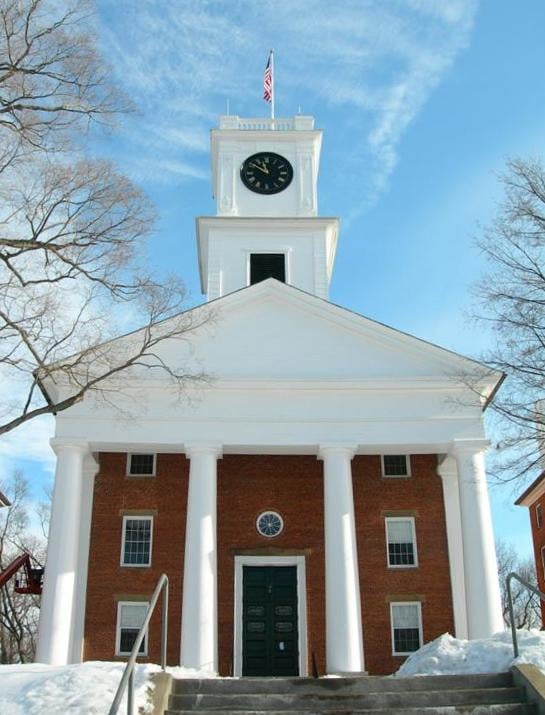
Johnson Chapel
Since the inception of the U.S. News & World Report rankings in 1987, Amherst College has been ranked ten times as the first overall among 266 liberal arts colleges in the United States,[31] and in 2016 ranked second, behind Williams.[14] In 2018, Amherst was ranked as the best liberal arts college in the country by the Wall Street Journal.[32] In 2018, Forbes ranked Amherst College as the 16th best college or university in the United States.[15]
Kiplinger's Personal Finance places Amherst 11th in its 2016 ranking of best value liberal arts colleges in the United States.[33]
Amherst ranked 4th in the 2018 Washington Monthly rankings, which focus on contribution to the public good in three broad categories: social mobility, research, and promoting public service.
According to The Princeton Review, Amherst ranks in the top 20 among all colleges and universities in the nation for "Students Satisfied With Financial Aid," "School Runs Like Butter," and "Top 10 Best Value Private Schools."[35]
Amherst also participates in the University and College Accountability Network (U-CAN) developed by the National Association of Independent Colleges and Universities (NAICU). Amherst's sustainability efforts earned it an overall grade of "A-" on the College Sustainability Report Card 2010 published by the Sustainable Endowments Institute.[36]
Admissions
Amherst has been dubbed one of the "most selective" liberal arts colleges in the United States;[42] the Carnegie Foundation classifies Amherst as one of the "more selective" institutions whose first-year students' test scores places these institutions in roughly the top fifth of baccalaureate institutions.[43] For the class first enrolled in Fall 2017, Amherst received 9,285 applications and accepted 1,198 (a 12.9% acceptance rate). 473 students ultimately enrolled; 82% were in the top 10% of their high school classes, and they on average scored a 2232 on the SAT and a 33 on the ACT. 38 states and 23 countries were reflected among the first-year class, 55% received financial aid and 11% were first-generation college students. In addition, 16 transfer students enrolled.[44]
Amherst's comprehensive tuition, room, and board fee for the 2012–13 academic year is $55,510. Once miscellaneous expenses are factored in the total cost to attend for the 2012–13 academic year amounts to $60,809–$63,259.[45]
Despite its high cost of attendance, Amherst College meets the full demonstrated need of every admitted student.[46] Sixty percent of current students receive scholarship aid, and the average financial aid package award amounts to $41,150; the average net price of attendance is $13,809 per year. College expenditures exceed $85,000 per student each year.[47]
In July 2007, Amherst announced that grants would replace loans in all financial aid packages beginning in the 2008-09 academic year. Amherst had already been the first school to eliminate loans for low-income students, and with this announcement it joined Princeton University, Cornell University and Davidson College, then the only colleges to completely eliminate loans from need-based financial aid packages. Increased rates of admission of highly qualified lower income students has resulted in greater equality of opportunity at Amherst than is usual at elite American colleges.[48]
In the 2008-2009 academic year, Amherst College also extended its need-blind admission policy to international applicants.[49]
Academics
Amherst College offers 36 fields of study (with 850 courses)[50] in the sciences, arts, humanities, mathematics and computer sciences, social sciences, foreign languages, classics, and several interdisciplinary fields (including premedical studies[51][52]) and provides an unusually open curriculum. Students are not required to study a core curriculum or fulfill any distribution requirements and may even design their own unique interdisciplinary major.[11] Freshmen may take advanced courses, and seniors may take introductory ones.
Thirty-five percent of Amherst students in the class of 2007 were double majors.[53] Amherst College has been the first college to have undergraduate departments in the interdisciplinary fields of American Studies; Law, Jurisprudence and Social Thought; and Neuroscience[54][55] and has helped to pioneer other interdisciplinary programs, including Asian Languages and Civilizations.[56]
Notable faculty members include, among others, modern literature and poetry critic William H. Pritchard, Beowulf translator Howell Chickering, Jewish and Latino studies scholar Ilan Stavans, novelist and legal scholar Lawrence Douglas, physicist Arthur Zajonc, Pulitzer Prize-winning Nikita Khrushchev biographer William Taubman, African art specialist Rowland Abiodun, Natural Law expert Hadley Arkes, Mathematician Daniel Velleman, Biblical scholar Susan Niditch, law and society expert Austin Sarat, Asian American studies scholar and former Director of the Smithsonian Asian Pacific American Center Franklin Odo, and Pulitzer Prize-winning composer Lewis Spratlan, professor emeritus of the music faculty.[59]
Academic freedom debate

The Kirby Memorial Theater
The writings of Amherst College political science Professor Hadley Arkes about homosexuality led to a dispute in 2013 over whether a college seeking to create a diverse, respectful academic community should speak out when a faculty member disparages community members or should instead remain silent as a way to protect academic freedom.[60] The issue arose when a group of alumni petitioned the college trustees and President Biddy Martin to "dissociate the institution" from Arkes's "divisive and destructive" views,[61] focusing particularly on his May 2013 comparison of homosexuality to bestiality, pedophilia and necrophilia.[62][63] The alumni said, "Amherst College cannot credibly maintain its professed commitment to be an inclusive community as long as it chooses to remain silent while a sitting professor disparages members of its community in media of worldwide circulation and accessibility."[61]
Martin disagreed, citing past debates over the college's position on the Vietnam War and apartheid in South Africa—issues on which the college initially remained silent but eventually took a public position. In such times, she said, colleges should "avoid taking institutional positions on controversial political matters, except in extraordinary circumstances" and should simultaneously both "protect their communities from discrimination and disrespect" and "cherish a diversity of viewpoints."[64]
Five College Consortium
Amherst is a member of the Five Colleges consortium, which allows its students to attend classes at four other Pioneer Valley institutions. These include Mount Holyoke College, Smith College, Hampshire College, and the University of Massachusetts Amherst. In addition to the 850 courses available on campus, Amherst students have an additional 5,300 classes to consider through the Consortium (without paying additional tuition) and access to 8 million library volumes. The Five Colleges are geographically close to one another and are linked by buses that run between the campuses.[65]
The Five Colleges share resources and develop common academic programs. Museums10 is a consortium of local art, history and science museums. The Five College Dance Department is one of the largest in the nation.[66] The joint Astronomy department shares use of the Five College Radio Astronomy Observatory, which contributed to work that won the 1993 Nobel Prize in Physics.[67]
The Five College Coastal and Marine Sciences Program offers an interdisciplinary curriculum to undergraduates in the Five Colleges.[68]
Campus
Amherst College is located in the town of Amherst in Western Massachusetts. Amherst College has a total of 34 residence halls, seven of which are strictly for first year students. Following their first year, sophomores, juniors, and seniors have the choice to live off campus and are offered options of Themed Houses including Arts House, Russian House, and French House, however this option is only available for two years of residence.[69]
The College also owns the Dickinson Homestead, operated as a museum about the life and history of poet Emily Dickinson, and the Lord Jeffery Inn (to be renamed[70]), near to the main campus.
Sustainability
Amherst College is reducing its energy consumption through a computerized monitoring system for lighting and the use of an efficient cogeneration facility. The cogeneration facility features a gas turbine that generates electricity in addition to steam for heating the campus.[71] Amherst also operates a composting program, in which a portion of the food waste from dining halls is sent to a farmer in Vermont.[71]
Student life
Amherst's resources, faculty, and academic life allow the college to enroll students with a range of talents, interests, and commitments. Students represent 49 states, the District of Columbia, Puerto Rico, and fifty-four countries.[72] Ninety-eight percent of students live on campus. Ninety-six percent of Amherst freshmen enrolled in Fall 2015 returned for their sophomore year; ninety-three percent of the most recent cohort graduated within six years.[8] There are more than 140 student groups at Amherst.[73] More than a third of the student body are members of a varsity athletics team.[74]
Students pursue their interests through student-led organizations funded by a student fee and distributed by the student government, including a variety of cultural and religious groups, publications, fine and performing arts and political advocacy and service groups. Groups include a medieval sword-fighting club, a knitting club, and a club devoted to random acts of kindness, among others.[75] Community service groups and opportunities (locally—through the Center for Community Engagement, nationally, and internationally) have been a priority at Amherst and for former President Anthony Marx, who helped start a secondary school for black students in apartheid South Africa.[76]
One of the longstanding traditions at the college involves the Sabrina statue. Even year and odd year classes battle for possession of the historic statue, often engaging in elaborate pranks in the process.[77]
Sexual assault
In 2012, President Biddy Martin began a community-wide review of the sexual misconduct and disciplinary policies at the College.[78][79] This review was sparked by several factors, including a fraternity's T-shirt design that critics alleged was misogynist[80] and an essay by Angie Epifano published in The Amherst Student, wherein she accused the college of inappropriate handling of a case of sexual assault.[81] In January 2013, a college committee published a report noting Amherst's rate of sexual assault as similar to other colleges and universities, and making recommendations to address the problem.[82]
After a complaint was filed by Epifano and an anonymous former student in November 2013,[83] the US Department of Education opened an investigation into the college's handling of sexual violence and potential violations of Title IX. In May 2014, the Department of Education announced a list of 55 colleges and universities (including Amherst) currently under investigation.[84]
A report from Amherst College stated that 2009 to 2011, Amherst reported 35 instances of "forcible sex offenses", a term that encompasses rape, attempted rape, and lesser forms of sexual contact.[85]
Mascot
The original unofficial mascot of Amherst College, Lord Jeffery Amherst, was a cause of concern in the Amherst community.[86] Many sought to separate the school from the problematic legacy of Lord Jeffery Amherst, in particular his advocacy of the use of biological warfare against Native Americans.[87]
In May 2014, after a wild moose found its way onto the Amherst College campus and into the backyard of the house of the college president,[88] students organized a Facebook campaign to change the mascot of the school to a moose.[89] The page grew rapidly in popularity, receiving over 900 "likes" in under two weeks,[89] and inspiring both a Twitter and Tumblr account for the newly proposed mascot. At the Commencement ceremony for the class of 2014, the moose mascot was mentioned by Biddy Martin in her address, and the Dining Hall served Moose Tracks ice cream in front of an ice sculpture of a moose.[90]
In February 2015, discussion of a mascot change continued when the editorial board of the Amherst Student, the college's official student-run newspaper, came out in favor of "the moose-scot".[89] In November 2015 the student body and the faculty overwhelmingly voted to vacate the mascot; the decision to drop the mascot was made official on January 26, 2016 after student anti-racism protests on campus.[91][92]
In April 2017, Amherst announced that their official mascot would be the Mammoth.[93][94] Mammoths beat the other finalists "Valley Hawks", "Purple and White", "Wolves", and "Fighting Poets" in a ranked-choice election process.[95] The Mammoth is linked to Amherst due to the long standing presence of a woolly mammoth skeleton on campus dating back to the 1920s excavation of the skeleton by an Amherst professor.
Athletics
More than one-third of Amherst's student body participates in sports at the intercollegiate level, and eighty percent participate in intramural and club sports teams.[96] Amherst participates in the NCAA's Division III, the Eastern College Athletic Conference, and the New England Small College Athletic Conference, which includes Bates, Bowdoin, Colby, Connecticut College, Hamilton, Middlebury, Trinity, Tufts, Wesleyan, and Williams College.[97] Amherst is also one of the "Little Three," along with Williams and Wesleyan. A Little Three champion is informally recognized by most teams based on the head-to-head records of the three schools, but three-way competitions are held in some of the sports.
Amherst claims its athletics program as the oldest in the nation,[98] pointing to its compulsory physical fitness regimen put in place in 1860 (the mandate that all students participate in sports or pursue physical education has been discontinued).[99] Amherst and Williams played the first college baseball game July 2, 1859.[100]
Amherst's growing athletics program has been the subject of controversy in recent years due to dramatic contrasts between the racial and socioeconomic makeup of its student athletes and the rest of its student body, the clustering of athletes in particular academic departments, and a perceived "divide" on campus between varsity athletes and other students. Athletic skill plays a factor in the admissions decisions of between 28% and 35% of each incoming class.[96]
Amherst fields several club athletic teams, including ultimate, soccer, crew, rugby union, water polo, equestrian, mountain biking, fencing, sailing and skiing. Intramural sports include soccer, tennis, golf, basketball, volleyball and softball.
Alumni
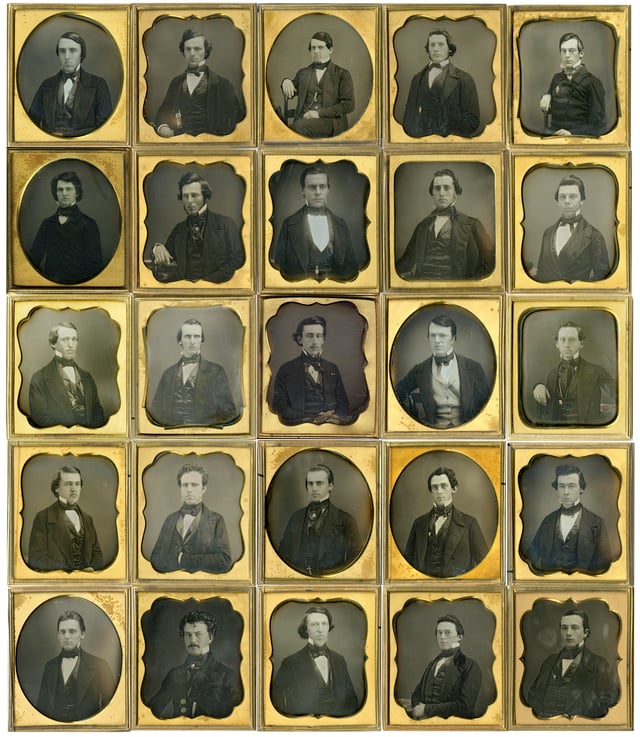
The Amherst graduating class of 1850, including William Austin Dickinson (second row, far left), brother of poet Emily Dickinson
Although a relatively small college, Amherst has many accomplished alumni, including Nobel, Crafoord Prize and Lasker Award laureates, MacArthur Fellowship and Pulitzer Prize winners, National Medal of Science and National Book Award recipients, and Academy, Tony, Grammy and Emmy Award winners; a U.S. President, the current Sovereign Prince of Monaco, two Prime Ministers and one Foreign Minister of Greece, as well as Uhuru Kenyatta, the fourth President of Kenya, a Chief Justice of the United States, three Speakers of the U.S. House of Representatives, a U.S. Poet Laureate, the legal architect of Brown v. Board of Education[103] and the inventor of the blood bank; leaders in science, religion, politics, the Peace Corps, medicine, law, education, communications, and business; and acclaimed actors, architects, artists, astronauts, engineers, human rights activists, inventors, musicians, philanthropists, and writers.
There are approximately 20,000 living alumni, of whom about 60% make a gift to Amherst each year—one of the highest alumni participation rates of any college in the country.[104]
Presidents of the college
Zephaniah Swift Moore, 1821–1823
Heman Humphrey, 1823–1845
Edward Hitchcock, 1845–1854
William Augustus Stearns, 1854–1876
Julius Hawley Seelye, 1876–1890
Merrill Edwards Gates, 1890–1899
George Harris, 1899–1912
Alexander Meiklejohn, 1912–1924
George Daniel Olds, 1924–1927
Arthur Stanley Pease, 1927–1932
Stanley King, 1932–1946
Charles Woolsey Cole, 1946–1960
Calvin Hastings Plimpton, 1960–1971
John William Ward, 1971–1979
Julian Gibbs, 1979–1983 G. Armour Craig, 1983–1984 (acting)
Peter Pouncey, 1984–1994
Tom Gerety, 1994–2003
Anthony Marx, 2003–2011
Carolyn "Biddy" Martin, 2011–
